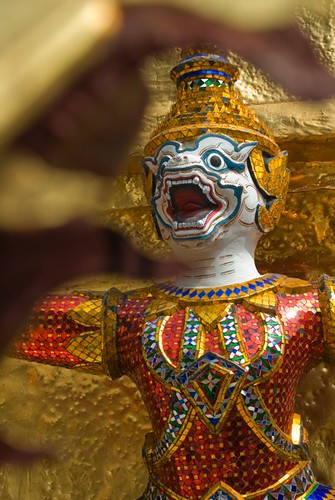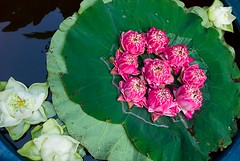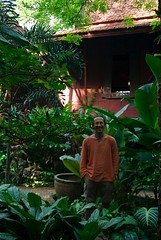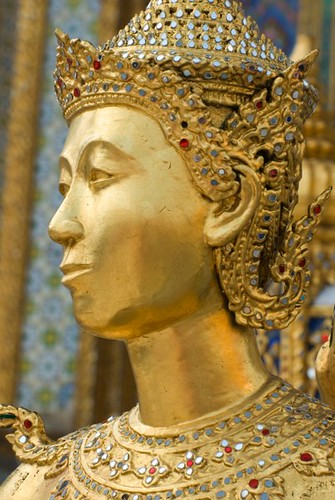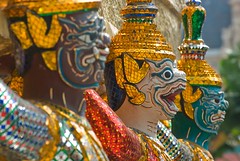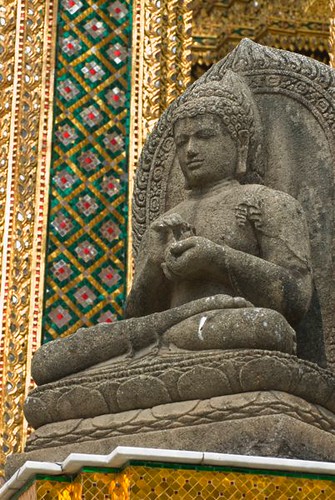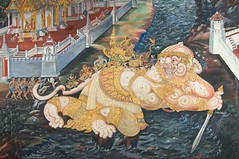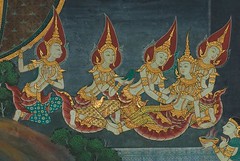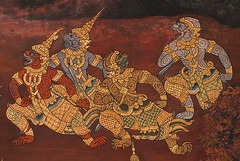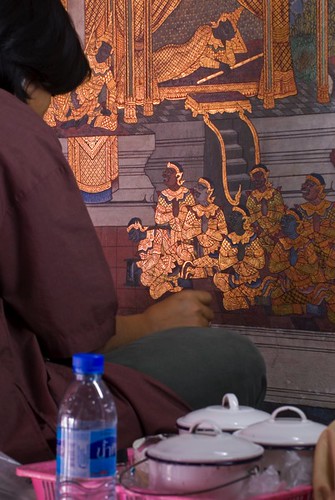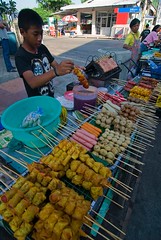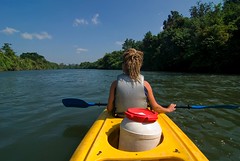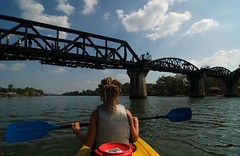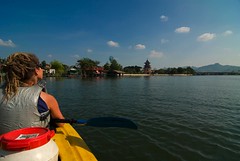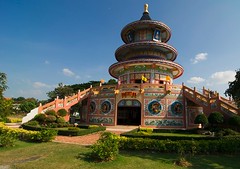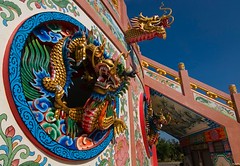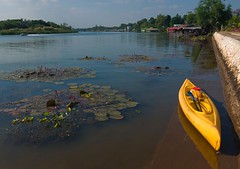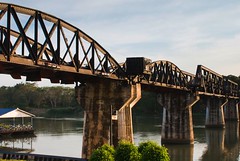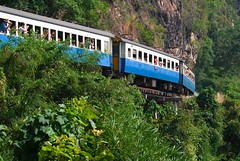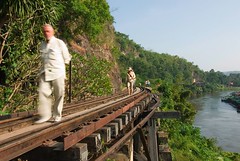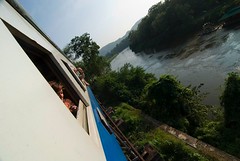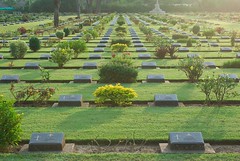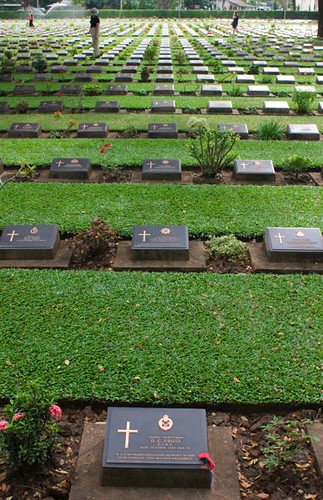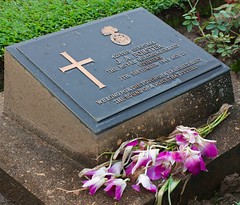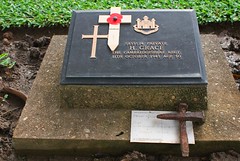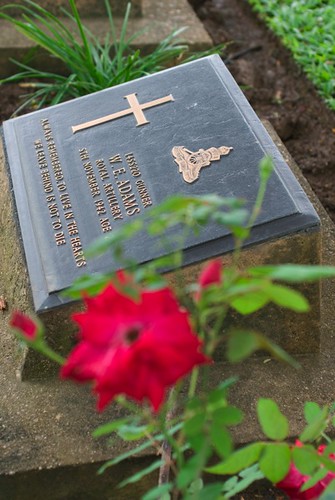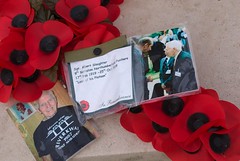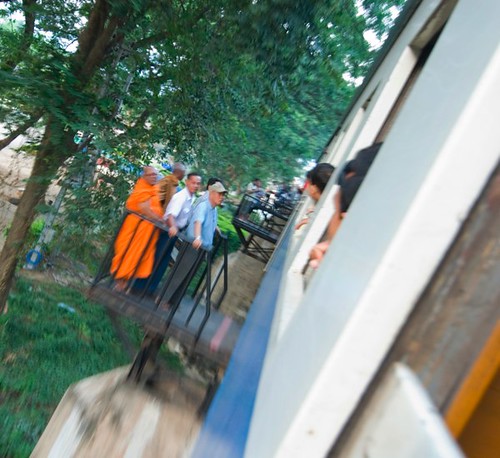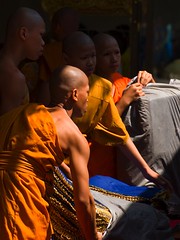Bathing with the Doctor Fish of the Elephant Falls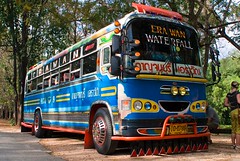 The bus back from Erawan had the destinations pretty clearly spelled out on the windscreen.
The bus back from Erawan had the destinations pretty clearly spelled out on the windscreen. We saw the blunt front end of the bus slowly making its away along the road, pick-up trucks and mopeds weaving around it. Luckily the driver also saw us, standing by the side of the road, opposite a pet food store that had done a roaring trade from passing moped riders in the 20 minutes we had waited, and pulled over. Georgia shouted ‘Erawan?’ over the clunking chug of the ancient engine, to which the driver nodded. Had he really heard as pistons thumped and the whole bus rattled? A quick double-check on our way up the steps confirmed we had and we were on our way for a two-night camping stay at Erawan National Park, home of a nationally famous seven-tiered waterfall.
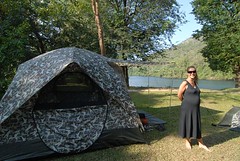 River View Camping
River View CampingA bone-shaking hour later and we were at the campsite, completing our camping hire form. A 150 baht 3 person tent rather than the smaller 90 baht 2 person version. Sleeping bags, pillows and what we would discover was optimistically called a lantern. Thai National Park tents are both excellent quality and enjoyable designed, being covered in a muted psychedelic abstract pattern of repeating trees, trunks and white birds. Our tent, kindly upgraded to a palatial 220 baht model for no extra cost, had a view of the River Kwai Yai, which also meant we could hear every vehicle along the road opposite.
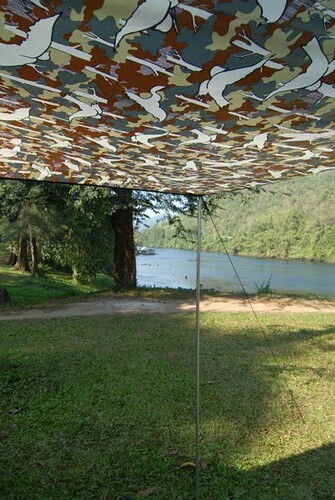
The waterfalls are worth more than the couple of hours romp that most tour companies give their groups. The clear cool blue water pours over a ridge to cascade over a series of limestone steps until it reaches flat ground 1.5km downstream. Most of the pools are created by the waterfalls themselves by depositing calcium carbonate in shelves, mounds and ridges in much the same way as limestone water furs up a kettle. Except in Erawan the process creates a series of amazing bathing pools, each with its own Jacuzzi and water massage system. Each of the seven tiers is extremely different in character depending on the nature of the waterfall and the pool created. What every tier shares is the experience of a jungle paradise with lush rainforest trees, creepers and palms crowding all around to create a vibrant green frames to cool blue pictures. David Hockney would surely be inspired to develop a Rousseauesque phase.
You can easily reach Erawan by bus from Kanchanaburi bus station. The one and a half hour journey takes you right to the Park HQ for 50 baht. There is also a 200 baht entry fee. It is easy to do it in a day as long as you remember the last bus back leaves Erawan at 4.00pm. Otherwise there are bungalows and, of course, the range of tents to hire at the HQ. By camping, we were given ourselves two and a half days to explore the falls and their surrounding jungle. It was a bit like having a festival with seven stages and numerous art trails. Each fall even had its own sound, a variation on rushing water set to different rhythms and pitches.
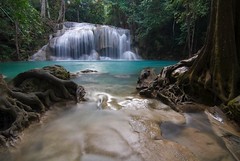 Erawan Two
Erawan Two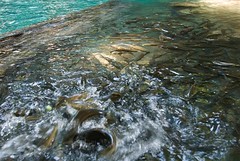 Feeding frenzy with Doctor Fish
Feeding frenzy with Doctor FishLevels one and two are both large bulbous falls that rush over wide, steep drops into series of swimming pools that continue downstream in wide steps. These are the family playgrounds, surrounded by bamboo platforms, toilets and food. Here, though, are the most vociferous of the ‘Doctor Fish’, a sort of trout-cum-catfish that nibbles your toes, feet, legs, in fact any part of your body while in the water for dry skin. The feeling can be a ticklish massage or a slithery hell depending on how you feel. Swimmers at level two have to brave the largest shoal of the biggest fish to get into the pool. Once swimming you’re completely safe from their raspy teeth but when you want to get out again…then it’s once more time to run the scaly gauntlet.
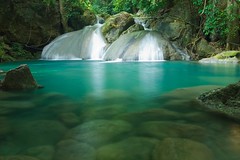 Erawan Four
Erawan FourWaterfall three is an impressive tall torrent hidden behind a bluff and difficult to get a clear view of how impressive the drop is or to slip into the pool for a swim. Quickly on to waterfall four, a large inviting pool backed by two large limestone mounds that the water seems almost to float over. A good clearing in the jungle creates a bright patch of sun-warmed water in the centre of the pool.
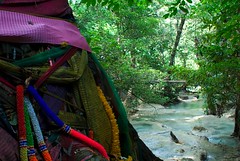
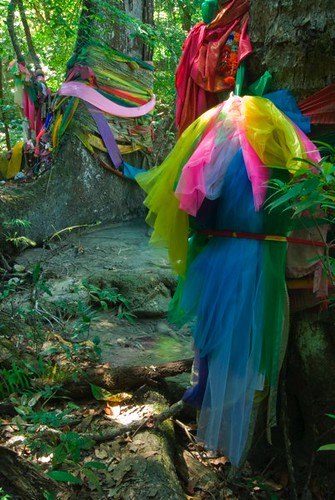 Water Spirit Houses
Water Spirit HousesThe longest trek is from four to five. It takes nearly 500m of scrambling uphill and climbing steep, rickety wooden steps, passing trees wrapped in brightly coloured cloths representing spirits houses. With Georgia being 5 and a half months pregnant we had to take it slowly. It wasn’t going to stop her however, and did enlisit one aside of ‘good girl’ from a passing tourist.
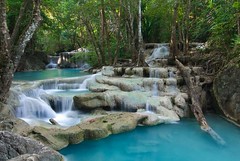 Erawan Five
Erawan Five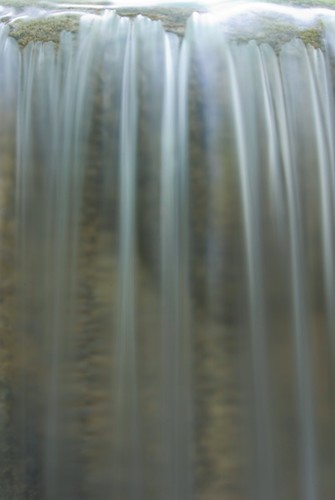
And waterfall five was worth the effort. For those who have visited Pamukkele in Turkey you will have a good picture of what waterfall five looks like. Here the falls are a series of broad, level cataracts formed of beds of calcium carbonate. The water falls and bubbles from one level to another over vertical edges reminiscent of their underground cousins – stalactites. This creates a natural spa of aquamarine pools of the clearest water, limestone steps connecting one to the other, and hydrotherapeutic massaging waterfalls complete with limestone benches to sit on. It seems that Paradise really does keep getting better the more steps you take.
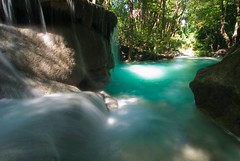 Erawan Five Downstream
Erawan Five Downstream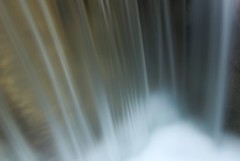
Which brings us on to waterfall six, as tall and hidden away a gem as three, kept secret by vines and trees, and to the finale – waterfall seven. This is the one that all the tour groups head towards. Waves of Russians, French, Britons, Thais and Americans, amongst many others, take off their trekking kit to reveal a wide range of skimpy, clinging, baggy or demure (depending on nationality) bathing gear and with trepidation walk, shuffle or leap into the pool. The air is filled with shrieks, not from cold water because the temperature of all the pools is pleasantly refreshing after the hike. The Doctor Fish, waiting at the edge of the pool for tourist toes to tickle and nibble, are the cause of the shouts. For most visitors this is their first experience of the slithering fish come to feed on their dead skin cells. It is enough to put many tourists off from taking the plunge. Other visitors keep still in disgusted pleasure, photographing the brown shoals fighting over scraps between their toes.
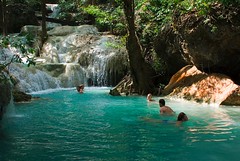 Erawan Seven with Georgia
Erawan Seven with Georgia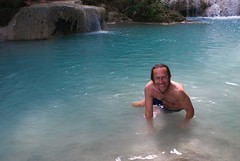 Like a James Bond film on a very bad day
Like a James Bond film on a very bad dayThe background to the pool is a steep series of limestone steps receding into the forest. Water cascades down them at a pace, forming a riot of many mini-falls that pound down from one to another. I scrambled up these, crossing a ‘ravine’ by a fallen tree, part of which was being ‘fossilised’ with calcium carbonate, pushing through branches and bracing myself against the force of the water. I felt almost adventurous enough to feel I could hold my own in a brief conversation with Ray Mears. Eventually the steps became too steep, the water too powerful to climb any higher. So I returned for a good swim in the pool below before descending all the way back to the very bottom via a swim and a fishy nibble in every other pool on the way. Except that I opted out of the feeding frenzy that awaited at waterfall two and instead enjoyed the recently arrived shrieking Russians discovering for themselves the Attack of the Thai Doctor Fish.
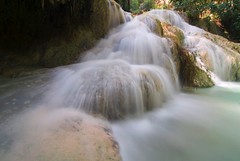 Erawan Seven as far as I went
Erawan Seven as far as I went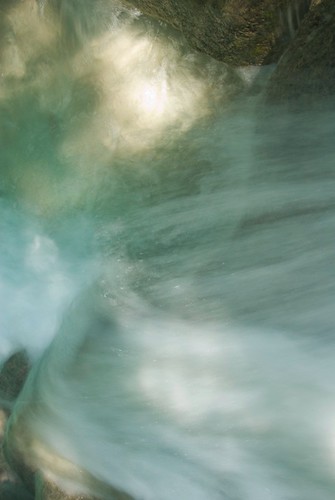 Water Lights
Water Lights
